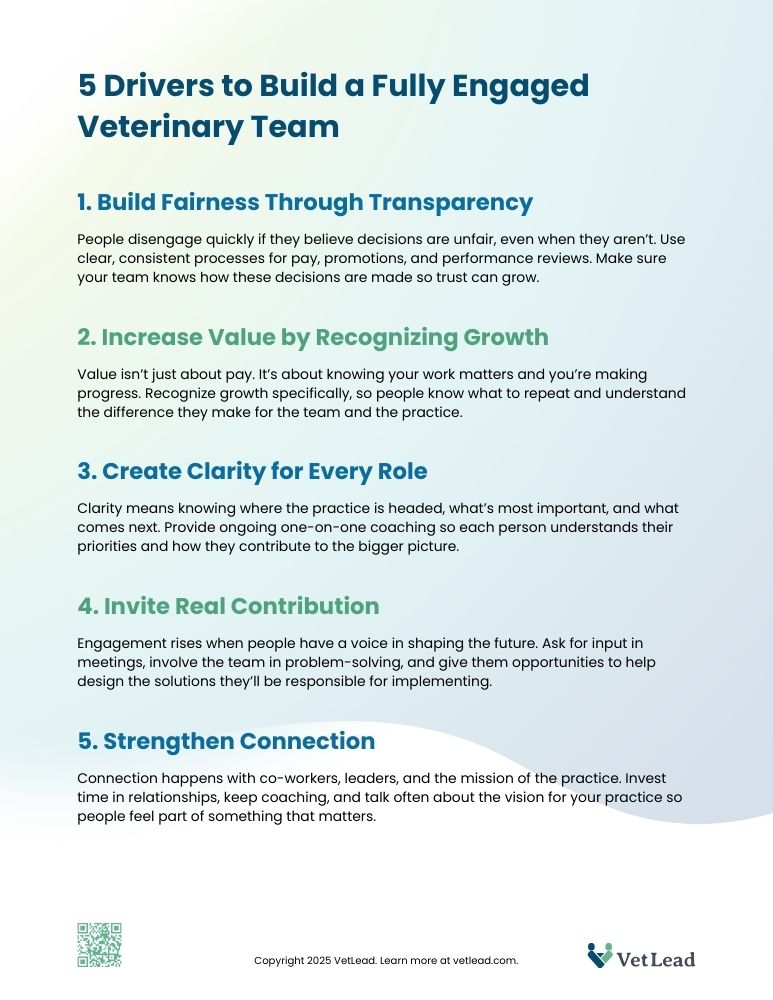What would your veterinary practice look like if every team member showed up ready to give their best, every single day?
Engagement is more than people doing their jobs. It’s when they bring energy, ideas, and extra effort because they want to. And research shows that about 70 percent of team-level engagement is determined by the manager. That means how you lead directly shapes how engaged your team becomes. That means you have an enormous opportunity to shape how engaged your team is.
When engagement is high, client service improves, the quality of medicine rises, and your practice becomes a better place to work. When it’s low, good people leave, performance drops, and your culture suffers. As a leader, you can either let engagement happen by accident or you can build it on purpose.
Five Drivers of Engagement You Can Influence Every Day
You don’t have to guess at how to build engagement. In every veterinary practice, there are a few areas that have an outsized impact on whether people show up ready to give their best. Focus on these five drivers and you’ll see changes in how your team works together, serves clients, and approaches challenges.
1. Build Fairness Through Transparency

If people feel like they work in an unfair environment, they disengage. Sometimes unfairness is real. Sometimes it’s just a perception. Either way, the impact is the same: effort and energy drop.
Pay, promotions, and performance evaluations are common places where fairness gets questioned. In veterinary medicine, word about raises travels fast. If someone hears a co-worker got a bigger raise and doesn’t understand why, they may assume favoritism is at play. Even if the process was fair, the lack of transparency creates doubt.
As a leader, you can build systems and processes that make fairness clear. For example:
- Use a consistent rating system for performance reviews.
- Link raises directly to those reviews.
- Make sure team members know the process and can see where they stand.
When people understand how decisions are made, they’re more likely to trust them and stay engaged.
2. Increase Value by Recognizing Growth
Value isn’t just about how much someone is paid. It’s about knowing the work you do matters, and that you’re making progress. If a technician improves their client communication skills or learns a new procedure, they should hear that it made a difference for the team, the practice, and the clients.
Specific recognition is key. “You’re a great teammate” feels nice, but “The way you handled that nervous client yesterday kept them calm and confident about their pet’s care” reinforces what to repeat.
You can build this into your daily routine. In morning huddles, take 30 seconds to highlight something a team member did that showed growth or improvement. Recognition that ties directly to value keeps people motivated to bring more of it.
3. Create Clarity for Every Role
Clarity means knowing where the practice is headed and how each person contributes to that future. It means being able to answer:
- What are my goals right now?
- What skills do I need to build?
- What’s the next step for me?
Many veterinary leaders provide clarity during onboarding or initial training but then let it fade. In a busy practice, it’s easy to assume people know what’s important. They may not.
One of the most effective ways to keep clarity alive is through regular one-on-one coaching. Some practices reorganize so leaders can have these conversations monthly, not once or twice a year. Even a brief, focused conversation can realign priorities, identify growth opportunities, and keep people moving toward their goals.
4. Invite Real Contribution

People are more engaged when they have a voice in shaping the future of the practice. This doesn’t mean every idea gets implemented, but it does mean ideas are heard, discussed, and considered.
One hospital I worked with brought cross-functional teams together every quarter for a half-day strategic session. They discussed what to improve in client service, medicine, communication, or efficiency, and then worked together to create the plan.
You can bring that same spirit into team meetings. Instead of running through a list of what needs to change, break into small groups and ask, “If we wanted to improve our client experience in the next 30 days, what would we try?” Small, team-driven changes are easier to implement and more likely to stick because the people doing the work helped design them.
5. Strengthen Connection
Connection fuels engagement. This happens in three ways:
- Connection to the people around me.
- Connection to my leader or manager.
- Connection to the mission of the practice.
The veterinary profession already tends to build strong peer connections, but the leader’s connection is just as important. When leaders coach, challenge, support people, and help them grow, engagement rises.
Mission matters too. If your team doesn’t know what you’re working toward as a group, it’s harder to stay motivated. A clear, shared vision of the kind of practice you want to become gives people something meaningful to pursue together.

5 Drivers to Build a Fully Engaged Veterinary Team
Download this free resource, share it with leaders and teams. No email address required.
Simple Actions That Reinforce Engagement in a Veterinary Practice
You don’t have to make massive changes to create an engaged team. Often, it’s the small, consistent things you do that make the biggest difference. Intentional actions can keep the five drivers alive in your culture, instead of letting them fade into the background when things get busy. Here are a few you can start using right away:
- Team Huddles: Use them to set short-term goals, recognize progress, and check in on learning opportunities for the day.
- Meetings with purpose: Spend more time on problem-solving and idea-sharing than on announcements.
- Hire for engagement: Use behavioral interview questions to uncover how candidates have contributed in the past, not just how they think they would in the future.
Start Small This Week
You don’t need to overhaul everything at once. Choose one driver - fairness, value, clarity, contribution, or connection - and take one step to improve it this week.
An engaged team doesn’t just happen. It’s shaped by leaders who are intentional about how they communicate, recognize, and involve their people. The more you focus on these habits, the more your team will show up ready to give their best, and the more your practice will thrive because of it.
What do you think? Other veterinary pros want to hear from you! Share your experience in the comments below.